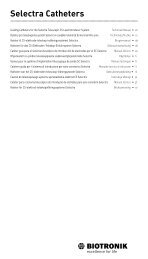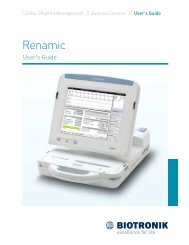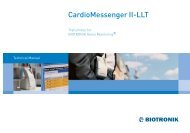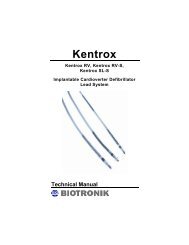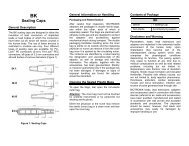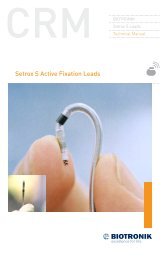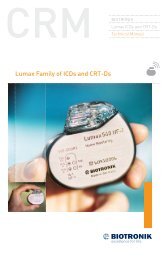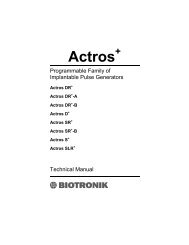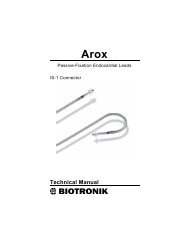Estella Pulse Generators - BIOTRONIK USA - News
Estella Pulse Generators - BIOTRONIK USA - News
Estella Pulse Generators - BIOTRONIK USA - News
You also want an ePaper? Increase the reach of your titles
YUMPU automatically turns print PDFs into web optimized ePapers that Google loves.
6.2.4 Clinical Study Conclusions<strong>Estella</strong> <strong>Pulse</strong> <strong>Generators</strong> Technical Manual 27The clinical data support the following conclusions regarding the safetyand efficacy of the ACC feature.The Philos DR ACC Pacing System is safe and effective for use in patientsthat are indicated for pacing therapy. The Philos DR ACC Clinical Studyfulfilled the predefined primary safety and efficacy endpoints. Theseendpoints included safety and effectiveness of the ACC feature.The gender distribution in this clinical investigation is consistent withother clinical studies and includes a representative proportion of femaleparticipants. There were also no significant differences found betweenhigh and low volume implant centers in either the safety or effectivenessendpoints.In accordance with the above conclusions, the clinical data providesassurance that the ACC feature is safe and effective for the treatmentof conditions requiring chronic cardiac pacing as specified in Section 2,Indications for Use.6.3 TRUST Clinical Study6.3.1 Study OverviewThe TRUST study is a multi-center, prospective and randomized trial.The purpose of the study was to demonstrate that the use of the<strong>BIOTRONIK</strong> Home Monitoring system (HM) can safely reduce thenumber of regularly scheduled office follow up visits, compared tothe conventional method of ICD follow-up. The assessment consistsof comparing the number of in-office follow-ups for patients with HM(HM group) versus patients without HM (Control group). With the use ofHM, the number of in-office follow up visits per year could be reducedfrom an expected five scheduled office follow up visits (3, 6, 9, 12 and15 months) to two visits (3 and 15 months). Additionally, the time fromonset to evaluation of arrhythmias in both groups was compared. It wasexpected that evaluation of cardiac events in the HM arm would occurearlier than those in the Control group.6.3.2 MethodsAll enrolled patients received a <strong>BIOTRONIK</strong> ICD with Home Monitoring/IEGM-OnlineÒ technology and were randomized to either Group 1 (HomeMonitoring (HM)) or Group 2 (No Home Monitoring (Control)) using arandomization ratio of 2:1.



